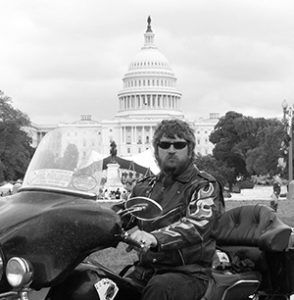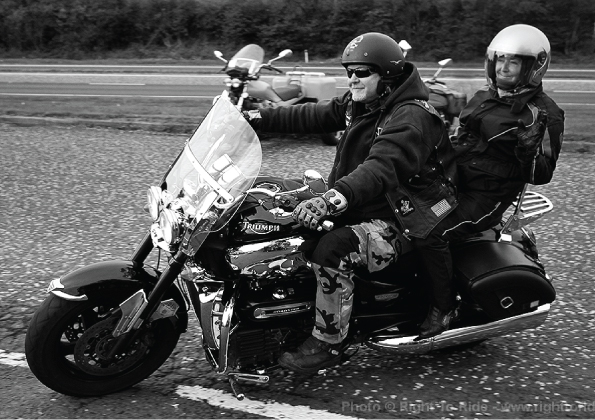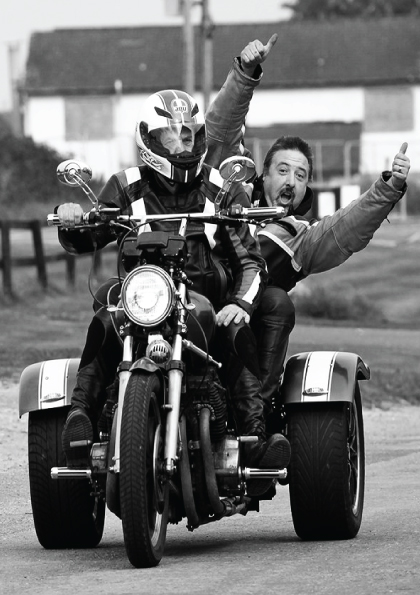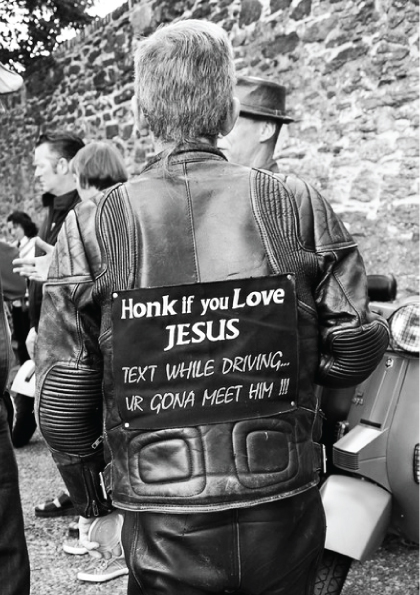 United States – This past weekend I was at an outdoor event with one of my sons. The motorcycles were out in full force, as riding season had just begun for the majority of riders here in the Northland.
United States – This past weekend I was at an outdoor event with one of my sons. The motorcycles were out in full force, as riding season had just begun for the majority of riders here in the Northland.
As we both turned to admire a pack of bikes going by, I noticed another boy about my son’s age standing with his father also looking on attentively with wide eyes. I’m sure many of us did when we were kids.
What happened next didn’t surprise me but after nearly 33 years of riding, it still bothers me as much as when I first heard it myself. The father said, (in part I am sure for my benefit since I don’t hide my love or involvement with motorcycles well), “Son, those things are dangerous”. I might have let it go had the boy not been admiring the bikes so much but because of that, I simply couldn’t.
When ridden well; around a non-riding public that respects motorcycles, they are the most enjoyable thing in life. You should encourage your son to be a part of that.”
Now before the calls and letters come in I understand if you’ve been around bikes very long you have a couple of stories where a bike sitting in a garage did reach out and bite you just a little.
Maybe when changing a head bolt or exhaust clamp after coming in from a day long ride because it bugged you so much you couldn’t wait for the bike to cool down to fix it, or changing the oil seconds after returning from the bike shop with an arm full of oil because you didn’t do it the night before the ride – and all your buddies are on your front lawn all leathered up glaring at you because you’re way late.
 Perhaps you changed out of your riding gear into a pair of shorts at the camp ground after a long ride and your leg hit the exhaust pipe when you went over to park it for the night (that hurts like sixty doesn’t it). Or while knocking out a bearing with a socket, hammer, and part of a finger because you didn’t want to waste the time to remove the part and put it into a press.
Perhaps you changed out of your riding gear into a pair of shorts at the camp ground after a long ride and your leg hit the exhaust pipe when you went over to park it for the night (that hurts like sixty doesn’t it). Or while knocking out a bearing with a socket, hammer, and part of a finger because you didn’t want to waste the time to remove the part and put it into a press.
Maybe you were showing off your new cart with little wheels that you can roll your bike around with and over it goes, or forgot to strap down your bike as you raised the lift and the bike let you know all about it as it attacked you. Or my personal favourite, before the days of computer interlock and back in the early days of gadgets – I had a buddy who installed a remote starter on his high dollar custom bike.
Well he loved to show it off and guess what happens when you hit a remote starter and the bike is in gear? It lurches forward and knocks you on your can and into two other bikes in the garage and over you and they all go. I still laugh till I cry every time I revisit that scene. But my point is motorcycles themselves are NOT dangerous.
I have said many times during motorcycling speeches, in testimony at hearings, during lobbying, or anytime when making a compelling case for motorcycles and safety that “No one has as much invested or cares more about my motorcycling safety than I do”, we all know crashing sucks, (some of us more than others) and we know we do not want to do it.
 I must state I have yet to see a motorcycle safety program that was not created by, developed by, taught by, supported by, lobbied for, run and administered by, or funded by a State Motorcycle Rights Organization (SMRO) or a National Motorcycle Rights Organization more effectively or meaningfully as the ones that are in play for us motorcyclists and by us motorcyclists.
I must state I have yet to see a motorcycle safety program that was not created by, developed by, taught by, supported by, lobbied for, run and administered by, or funded by a State Motorcycle Rights Organization (SMRO) or a National Motorcycle Rights Organization more effectively or meaningfully as the ones that are in play for us motorcyclists and by us motorcyclists.
As I think about the various motorcycle safety related initiatives we have developed and embraced as motorcycle rights activists over the years, I can’t help but be convinced that if all of us worked diligently on them, then motorcycle riding could or would no longer be “seen” by outsiders as dangerous because the results would be so outstanding.
Take a look at the following list and take an inventory of the ones you are involved with as a State Motorcyclist Rights Organization, an SMRO or an MRF member, or simply as an interested rider who happened to see a copy of The Reports. What level, and where, more importantly, do you see something that piques your interest and encourages you to take a deeper look.
- Take a beginning rider education course followed by an advanced rider education course and encourage all your fellow SMRO members and riders you come across in conversation to do the same
- Take a two-up and/or sidecar course where offered, and if so inclined, a track riding class
- Strongly support rider education programs in your state, support the funding of these programs, work to protect funding from being misappropriated into state general fund coffers and away from rider funded rider education
- Encourage your local dealers to be certain that riders are made aware of the various methods in the area to enhance rider skills. This is especially important for customers who are new or returning to riding or if there’s a substantial change the type of bike being ridden
- Actively participate in your state motorcycle safety advisory boards and councils and hold a position on them where possible
- Encourage responsible riding – the first death in Wisconsin in 2010 was a new rider hitting a parked car while doing a wheelie
- If you’re experienced, take a young rider under your wing and teach them the ropes and how to respect motorcycling much like someone so effectively did for me years ago. If new to riding, find an old grey beard to teach you the way of motorcycling – you won’t regret it
- Have an active Share the Road program to educate the non-riding public
- Have an active (un)impaired peer to peer riding program, have options in place for impaired riders such as the Dial a Ride program in Minnesota or Indiana
- Have an active May is Motorcycle Awareness Month program or whenever large groups of riders are expected to hit the roads
- Celebrate your states May is Motorcycle Awareness Month proclamation; lobby for one if you don’t yet have one
- Hold Motorcycle Awareness Rallies, especially if riding season is intermittent
- Advertise to the public when a large gathering of motorcyclists will be joining their communities, they need to be aware of us
- Work with your DOT and transportation officials for motorcycle specific signage and utilize the amber alert signs when not in use to promote motorcycle awareness as several states have been successfully doing recently
- Lobby for enhanced safety measures if beneficial to safety in your states such a red light through bills, filtering (lane splitting) etc.
- Have an active enhanced Right of Way (ROW) violation program, consider making Share the Road classroom mandatory for violators
- Have an active ROW follow up program for law enforcement personnel, judges, and courtrooms
- Make Share the Road with Motorcycles mandatory training in first time driver education classes
- In states with deer crash issues forge a relationship with your state department of fish and wildlife/natural resources to address it
- Participate in any official reviews of your State Motorcycle Safety program, have a working relationship with the State Program Administrator and any agencies that impact motorcycles and motorcyclist’s safety.
- Fully utilize Federal Motorcycle Safety Grant Funds created by, lobbied for, and paid for by the SMRO’s and the MRF, continue to lobby for this program. (it was recently extended on a continuation outside of the overdue next highway bill)
- Continue to support the MRF in their endeavors to keep the Federal Highway Administration Motorcycle Advisory Council relevant as well as support our interactions with the many federal and international agencies and bureaucracies that have taken an interest in us and our safety by remaining involved
- Attend the MRF’s Bikers Inside the Beltway Federal Motorcycle Awareness event and Lobby Day in Washington D.C.
- Lobby whenever and wherever to continue to bring a positive light to motorcycling
- Most importantly, when riding be an ambassador for yourself, your organization, and the MRF. It will pay dividends
 I wrote a column a few years back that was widely distributed, entitled “WITH FREEDOM COMES RESPONSIBILITY”. It is as true today as it was back then and – as long as there is motorcycle riding, we have a responsibility to take an active and engaged role in our safety. After all, no one can or will do as good a job at it as we will.
I wrote a column a few years back that was widely distributed, entitled “WITH FREEDOM COMES RESPONSIBILITY”. It is as true today as it was back then and – as long as there is motorcycle riding, we have a responsibility to take an active and engaged role in our safety. After all, no one can or will do as good a job at it as we will.
I fully believe if we continue down an aggressive path to educate ourselves and the non-riding public through known and effective means such as those above while we work with officials who believe they are responsible for our safety and to highlight what we have available that works, then we will achieve our goals.
Most importantly, if we hold ourselves and the non-riding public fully accountable for our actions, then we will no longer need to endure the words “motorcycles are dangerous”, because, we know and the motoring public will know that motorcycles are NOT dangerous.
Kirk “Hardtail” Willard
MRF (Motorcycle Riders Foundation) President


I convinced my wife to let me get another bike, a dual sport bike for mainly fire roads and easy to moderate trail riding. My argument, was that it would be a great hobby for her father and I to do together…and with that “kind of riding” we can’t really get hurt. 3 weeks ago my father broke his tib and fib leg bones on a gravel road with pot holes. Was wearing heavy mx boots…or his bones would surely have penetrated the skin. Nasty brake and had surgery requiring a rod, pins and screws from under his knee to his ankle. Lots of downtime for him. He loves riding bikes, but I just sold his DRZ400 and KLR650 for him. Sold my DRZ also, we are switching to a Jeep for our forest adventures. My wife doesn’t want me to get hurt like that (and either do I). That down time could ruin me financially.
Bottom line is that my love of bikes, and riding, caused me to take risks that I probably shouldn’t as a family man. A high school chum lost his life and I know other guys dealing with lifetime brain damage due to bike accidents. Usually not their fault either. They are dangerous unfortunately. Very, very fun I agree. But dangerous all the same. All the training, practice, alertness, and expensive gear can’t save you from something as simple as 16 year old texting her friend while driving. Those things are needed, and can certainly move the odds in your favor towards survival in the case of a severe crash…but to think you are actually safe from harm is only living in denial. It’s a calculated risk. If the fun of riding is worth the risk of injury or death, than it’s worth it to you. I decided it’s not worth it to me. Either is black diamond ski runs, free climbing, base jumping, etc.
I retired from the fire service after 22 years. Many of the fatalities and severe injuries of motorcycle riders I responded to would likely have been minor incidents if they were in a car or truck. You can save all of your hype. Motorcycles are dangerous and to argue against it is to deny all knowledge of science and physics. If they aren’t dangerous then why are you guys always pleading for us to watch out for you?
The opposite of dangerous is safe and motorcycles are not that either.
Determining if something is safe or dangerous can be done by comparing them against other products that performs the same (or similar) functions.
Motorcycles are more safe than walking in the middle of a highway at midnight wearing all black, not as safe as a car, truck, or SUV.
A car accident you can walk away from could kill you easily on.a motorcycle.
So does that make cars safe? No…but safer than motorcycles. Telling someone that a motorcycle is safe is probably less close to the truth than telling them it is dangerous.
Motorcycling can be made safer, but it can not be made safe. That should be obvious. Perhaps the manufacturers could be doing more to make motorcycles safer—for example, Honda has one model of GW with an airbag. Is it effective? If so, why doesn’t Honda publicize the evidence? Does Honda know something they aren’t revealing?
In reality, good and right thinking.
Motorcycle are not dangerous human stupidity itself is.
I used to get quite annoyed when people used to tell me that motorcycles were dangerous.
Most of the time the people were ill informed and quite plainly prejudiced against us but deep down I think that quite a number of them were actually envious as they tended to make their anti motorcycling comments when they were with a group or with a spouse /partner and their children.
I still get this anti motorcycle prejudice when I am booking people in for rider training, strangely and usually from mothers who are allowing there children to ride a small machine, over here in the UK all new powered two wheeler riders have to undergo compulsory basic training before they can ride as a learner on the public highway.
I have quite often pointed out that more people suffer serious injury and even death falling down stairs than they do on a motorcycle.
I do have to say that collectively as motorcyclists we are masters of our own downfall, certainly in the UK our main problem is a very small proportion of anti social riders, mainly these riders have very noisy exhausts, ride excessively fast and do dumb things like pull wheelies and overtake in dangerous places.
I have had to act as a mediator between the police and motorcyclists when police motorcycle action days have taken place. I used to be heavily involved with riders rights as I was a British Motorcyclists Federation (BMF) regional chairman for over 10 years as well as the BMF Rider Training Scheme general manager.
I may be classed as a boring old fart but I have on quite a number of occasions had to try to justify why motorcycles are safe to various local road safety initiatives and local residents panels in the villages which are affected by these irresponsible riders either killing themselves or having serious accidents.
I agree with you Kirk in that it is education which really is the way forward mainly its the riders who need educating closely followed by car / truck drivers and the general public, unfortunately this education has a cost and finding the funding is the most difficult part given the current global financial problems.
I would think that in the US it is much more difficult a process to get education measures in place due to the size and of the country and the differing laws within the various states.
Its probably easier in over here in Europe and particularly in the United Kingdom as we have centralised government transport authorities.
Even then our governments always seem to take the easy way to road safety by putting what we regard as anti motorcycling legislation in place as they well know that we do not have enough financial clout nor do we have a unified approach between us the motorcyclists and the manufacturers / importers.
As far as I am concerned an example of this is that in the UK we do not yet have compulsory daytime lights (its coming in but not quite at this time) yet all new European and Japanese motorcycles no longer have a light switch fitted, the reason is not for safety but because the manufacturers decided to support the so called safety issue it saves them time and money because they don’t have to fit a switch.
Ian Lee